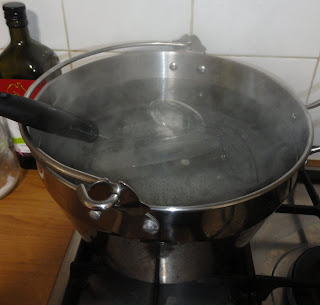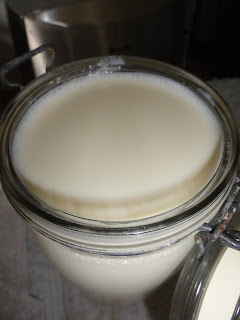For use on worker’s greasy or dirty overalls, football and sports uniforms or fabric that has food spills.
- 2 cups grated Napisan or Sard soap or 2 cups of oxybleach powder (Napisan or the generic equivilent)
- 2 cups grated laundry or homemade soap
- 2 cups borax
- 2 cups washing soda
Mix all the ingredients thoroughly and store in a plastic container with a lid. Use two tablespoons per wash. The powder will not make suds. For a very heavily stained load of washing or tradesperson’s clothes, if you have a top loader let it fill with water and start working, then turn the machine off when the powder is dissolved. In a front loader, operate the machine to dissolve the powder and then stop the machine for an hour to soak the clothes. Leave to soak for an hour, or overnight, and then turn the machine on and continue washing as normal.
STAIN REMOVER
½ cup laundry liquid, rubbed into the stain, will remove many stains. Rub the liquid in with your finger tips, let it sit for 30 minutes, then wash as normal.
FABRIC SOFTENER
½ cup white vinegar in final rinse
SOAKER and WHITENER FOR STAINED NAPPIES/DIAPERS
Bicarb soda (baking soda) is a good for soiled nappies. Dissolve ¼ cup of bicarb soda in a bucket of warm water, soak for at least an hour or overnight, then wash the nappies in hot water with homemade laundry liquid. Add ½ cup of vinegar to the final rinse and let them dry in the sun.
ALL-PURPOSE CLEANER #1 - spray
Nellymary has a post on making citrus vinegar which is a good old fashioned general cleaner.
Her post is here. You can make a similar cleaner using lavender leaves and flowers or, for the Australians, lemon myrtle leaves.
ALL-PURPOSE CLEANER #2
½ cup washing soda
2 litres warm water
Mix together and store in a sealed container that is marked with the name. Can be used as a floor cleaner – tiles, laminate or vinyl or for general cleaning of walls, counter tops or sinks.
CLEANING SILVER
This method works by a chemical reaction between aluminium, salt and bicarb soda. Put the plug in the kitchen sink. Lay a piece of aluminium foil on the base of the sink and add your silverware. Pour in enough boiling water to cover the silver.
Add one teaspoon of bicarb soda and one teaspoon of salt to the water. Let it sit for about ten minutes. The tarnish will disappear without you touching it. Rinse and dry.
CREAMY SOFT SCRUBBER - a good bath cleaner
Simply pour about ½ cup of bicarb into a bowl, and add enough laundry liquid to make a texture like thick custard. Scoop the mixture onto a sponge, and start scrubbing. This is the perfect recipe for cleaning the bath and shower because it rinses easily and doesn’t leave grit.
Note: Add 1 teaspoon of vegetable glycerin to the mixture and store in a sealed glass jar, to keep the product moist. Otherwise just make as much as you need at a time.
WINDOW CLEANER # 1
¼ - ½ teaspoon liquid or grated soap
3 tablespoons vinegar
2 cups water
spray bottle
Put all the ingredients into a spray bottle, shake it up a bit, and use as you would a commercial brand. The soap in this recipe is important. It cuts the wax residue from the commercial brands you might have used in the past.
WINDOW CLEANER # 2
Vinegar and newspapers
Pour a little vinegar onto a sheet of newspaper and wipe windows. Remove all the grime and polish the window with a clean sheet of newspaper.
FURNITURE (WOOD) POLISH
½ teaspoon olive oil
¼ cup vinegar or fresh lemon juice
Mix the ingredients in a glass jar. Dab a soft rag into the solution and wipe onto wooden surfaces. Seal in the glass jar and store indefinitely.
FLOOR CLEANER – tiles, vinyl or laminate
½ cup white vinegar plus 2 litres hot water in a bucket and a clean mop will clean up all but the worst floor. If you have a really dirty floor to deal with, add a squirt of homemade laundry liquid to this mix.
WOODEN FLOOR CLEANER - Ammonia will strip floor wax (one cup to a bucket of hot water)
2 tablespoons homemade vegetable soap - grated
½ cup vinegar
500 mls strong black tea
bucket warm water
Combine all the ingredients in the bucket and wash with a mop.
MOP CLEANING
A clean mop is a necessity when cleaning floors. If you start with a dirty mop you’ll just loosen the dirt on the mop by making it wet again and then spread that on the floor. When you finished your cleaning jobs, rinse the mop out to get rid of the loose dirt, rinse the squeeze as much water out as you can, then dry the mop in the sun.
CLEANING RAGS
Instead of buying cleaning rags or Chux, recycle your old towels and flannelette sheets. If you've kept your towels going for as long as you can, or you find a rip in a sheet that's already been mended a few times, cut them up and use them as cleaning rags. After all that wear, they'll be soft and absorbent, and just the thing to help you clean your home. If you're cutting up a fitted sheet, use the old elastic in the garden to tie up your tomatoes.
REMOVING CRAYONS FROM A PAINTED WALL
Add a few drops of water to some bicarb and make a thick paste. Wipe over the crayon marks and scrub off with a terry cloth.
HOMEMADE TOOTHPASTE
¼ cup cooking salt or any natural salt.
¼ cup bicarb soda
Make up ½ cup at a time and store it in a sealed jar. Just sprinkle some of the powder onto your toothbrush and clean your teeth in the normal way. This powder is bitter and takes a little while to get used to but it works well. You could add a few drops of peppermint essential oil to mask the taste.
HOMEMADE SHAMPOO
This works very well. Say goodbye to all those expense hairdresser shampoos.
Dissolve a tablespoon of bicarb soda in a cup of water. If you’ve got children, it might be better doing this in a squirt bottle.
Wet hair thoroughly and apply the mixture to the hair, massaging it in well.
To rinse, just run water through your hair, or you could use a splash of vinegar. The vinegar smell will go when your hair is dry.
You’ll be amazed at how good your hair feels. It will be clean and healthy.
This is an excellent shampoo for long and frizzy hair or short hair.
HOMEMADE DEODORANT
Add some bicarb to a shaker and use that. Dabbing a bit of bicarb under your arms is very effective as long as you wash every day.
Please add your favourite homemade cleaner in your comment. I'm always happy to try new cleaners and ways of cleaning.



















































